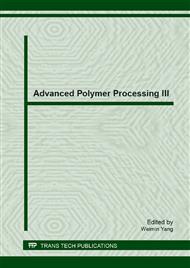p.80
p.86
p.91
p.95
p.101
p.107
p.113
p.119
p.125
Numerical Study on Heat Transfer Enhancement Performence of the Helical Blade Rotors
Abstract:
Based on the advantages of polymer materials over other materials, rotors which are made of the polymer material, are the functional elements of the rotor-assembled strand, and rotate under certain mass flow rate to obtain heat transfer enhancement and online automatic cleaning. The paper carried out numerical studies on heat transfer and friction loss characteristics of the tube fitted with rotors of different spaces. The comparison of the field synergy angle between plain tube and the tube fitted with rotors was also presented in the paper. The numerical data had good agreement with the experimental data. The numerical studies indicated that the field synergy angle of the rotors inserted tube were significantly smaller than that of the plain tube, which validated that the rotors could significantly enhance heat transfer process and had a better comprehensive performance of heat transfer enhancement though extra friction loss was generated. In addition, both the Nusselt number and friction factor of the tube fitted with rotors increased with the increasing space between rotors; the thermal performance factor of the rotors were all higher than 1, which validated the heat transfer enhancement function of the rotors; meanwhile, the thermal performance factor increased with the space between rotors.
Info:
Periodical:
Pages:
101-106
Citation:
Online since:
July 2013
Authors:
Price:
Сopyright:
© 2013 Trans Tech Publications Ltd. All Rights Reserved
Share:
Citation:


